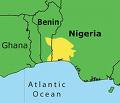 Case Studies Case Studies
The Yoruba and their fungi
The Yoruba people live predominantly in western Nigeria. B.A. Osu (of the Department of Botany at the University of Ibadan) visited towns and villages in western Nigeria to investigate Yoruba fungal knowledge. He reported a number of his findings in the paper listed at the end of this page. In this report of some of Oso's work I will give Yoruba words in bold, with the English translations italicised and in square brackets. Non-bracketed italicized words are of course species names.
In some parts of the Yoruba lands the word for fungus or mushroom is olu [anything that is more prominent or which rises higher than any other thing in its environment], because mushrooms are easily distinguished from the surrounding plants. In other regions the word osun is used. This is derived from sun [sprout], for mushrooms appear suddenly in the fields.
The Yoruba fungal names are based on various features, such as taste, shape, growth habit, texture or habitat. Takele [ta=distinguish + okele=morsel; hence a mushroom which makes a delicious meal] is the species Termitomyces clypeatus. The species of this genus grow in association with termite nests and a number of them are valued as food. Takele also goes by the names olu-esunsun [esunsun=winged termite] and, because it appears at the beginning of the rainy season, olu-abojose [ba=with + ojo=rain + se=begin]. This is also the time when yams of the previous year are rare and very expensive and the appearance of this mushroom indicates that new yams should be available in two or so months. Ewe [expand] is Termitomyces robustus and the mushroom caps, globular at first, expand and open out to become almost flat. While ewe is the most popular edible mushroom Oso reported that the people in the town of Efon Alaye traditionally did not eat ewe and there is a story to explain this. In an old tribal war the inhabitants deserted the town when they heard of the approach of enemy warriors. By the time those warriors reached the town ewe had already grown over the escape route and so covering the footprints of the fleeing populace. When the enemy warriors saw the mushrooms they reasoned that had the people fled that way the mushrooms would have been crushed. The warriors therefore turned back and went elsewhere. The mushrooms that saved the townsfolk were therefore considered sacred and the eating of them has, ever since, been forbidden in the town.
Ese-adie [ese=leg or foot + adie=chicken] is so-called because the lobed shape of this fungus, Schizophyllum commune, resembles a chicken's foot. Etiologbo [eti=ear + ologbo=cat] is the Yoruba name for both Auricularia auricula and Auricularia polytricha, the fruiting bodies of which are gelatinous in texture and ear-like in shape. The genus Auricularia is found worldwide and the concept of "ear" turns up in the common names for the species of this genus in many countries. Olu-awo [awo=leather] has tough texture and this fungus is also known by the Yoruba name of erirokiro [eri=that which + rokiro=very tough]. This is the species Lentinus sqarrosulus and a tough, leathery texture is common in the genus Lentinus. Wowo [wo=break] is the species Psathyrella atroumbonata, the fruiting bodies of which are very small and brittle. In fact brittleness is a characteristic of many of the mushrooms in this genus.
Ajeimutin [je=eat + imu=without drinking + otin=alcohol] is the species Coprinopsis africana. It was originally named as Coprinus africanus but relatively recent research has shown that the old genus Coprinus (the "Ink Caps") has warranted dividing into several genera. The Yoruba have learnt that eating this species is safe, unless alcohol is taken with or soon after eating the mushroom. The same is true of Coprinopsis atramentaria (formerly Coprinus atramentarius) a species well-known in the Northern Hemisphere.
Reference
Oso, BA. (1976) Mushrooms and the Yoruba people of Nigeria. McIlvainea, 2(2), 66-73.
|
![An Australian Government Initiative [logo]](/images/austgovt_brown_90px.gif)


![An Australian Government Initiative [logo]](/images/austgovt_brown_90px.gif)

